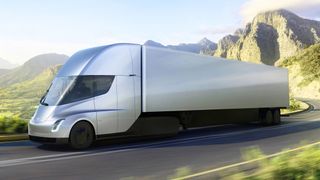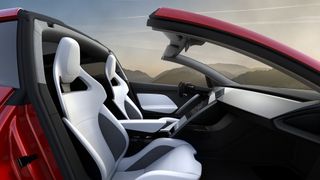The specs of the Tesla Roadster are simply mind-boggling

Tesla is in a unique position right now. It's not a new company — the first examples of the first-generation Tesla Roadster rolled out nearly ten years ago. It's also not a huge company, as far as an automaker is concerned, but the have massive ambitions. And despite a history of not being able to deliver products on time and rarely managing a profitable business, Tesla is still aggressively expanding their charging infrastructure, manufacturing capacity, and product line-up.
Two long-anticipated expansions of that line-up came this week: the Tesla Semi and the second-generation Tesla Roadster — the latter of which came as a surprise "one more thing" to end the planned Semi unveiling. Tesla's Elon Musk is in no way the master showman that was Steve Jobs and his legendary Apple events, but he has something else up his sleeve: an earnest and goofy excitement and energy about the latest in electrified transport.
Tesla Semi will shake up cargo
The event was ostensibly to unveil the Tesla Semi. It might seem like an odd choice for Tesla — after working through a progression of electric vehicles from the expensive original Roadster to the Model S and X and the relatively affordable Model 3 — but the Semi is in many ways a natural extension of Tesla's business.
The Semi takes much of Tesla's existing tech and simply scales it up to cargo hauler size.
Unlike with internal combustion vehicles, scaling an electric drivetrain to haul heavier loads actually isn't that complex. The Semi takes much of Tesla's existing tech and simply scales it up. A semi truck needs more power, so Tesla took the drive motor from the Model 3 and put four of them in the Semi (one on each of the four rear wheels). To provide power to those motors, Tesla simply built a larger battery pack (the cars already have packs composed of thousands of cells, so the Semi's power needs are met with a pack with even more cells). It even utilizes minor hardware bits from other Tesla cars, like borrowing its screens and door handles from the Model 3.
Because this is an electric vehicle, it has some intrinsic advantages over a standard diesel-fueled truck. There's the acceleration, which has long been an EV bonus, and the Semi manages a 0-60mph time of 20 seconds — with a full 80,000-pound load. As anybody that's been stuck behind a fully-loaded semi truck trying to accelerate on a highway on-ramp will tell you, that's not just a godsend for the truck driver, it's a huge thing for other cars on the road. The massive power on hand means that the Tesla Semi will also be able to manage better speeds when climbing steep hills, and as an electric vehicle it can use regenerative breaking (using the motors in reverse as generators) to slow the truck, put power back into the battery, and massively reduce wear on the brakes.

There are also the electrical disadvantages. The first is price — semi trucks aren't cheap, and neither are electric cars, so you can expect that the Tesla Semi will be quite expensive. Tesla's been mum about the price, but they're taking reservations at $5,000 a truck and claiming $200,000 in fuel savings with "a two-year payback period" versus diesel trucks.
The other is range and refueling time. The massive battery pack and class-leading aerodynamics help somewhat with this, offering between 300 and 500 miles range for a Tesla Semi, but refueling is still an issue. To alleviate that, Musks sketched out a vision of having Superchargers at the loading docks for the Semi to top off its battery while shuffling cargo in and out of the trailer. For longer distance travels, Tesla's planning a network of Megachargers that take the direct DC charging of the Supercharger network and turn up the voltage and amperage to put 400 miles into a Semi battery pack in half an hour. That's still a far cry from the 15-minute refueling of a 300-gallon diesel tank that'll drive for 1500 miles, but long-haul trucking is a small portion of the overall trucking environment.
Master your iPhone in minutes
iMore offers spot-on advice and guidance from our team of experts, with decades of Apple device experience to lean on. Learn more with iMore!
With a 500-mile range and long charge times, the Tesla Semi won't yet take on long-haul diesel trucking.
Tesla's bringing their Enhanced Autopilot system to the Semi as well, which is a key differentiator for the Semi. Enhanced Autopilot rolls together a long-range radar, short-range ultrasonic sensors, and a suite of cameras to advanced provide lane-keeping and adaptive cruise control to Tesla vehicles, and its expansion to Semi trucks means that it'll be a big boon to professional drivers. Anybody who has driven long distances in an Autopilot-equipped Tesla will tell you what a huge difference it makes — it's far from the point of being able to tilt the seat back and take a nap, but even in its current state it makes driving far less mentally taxing.
Tesla says to expect the first Semis to roll out of their factory by the end of 2019, and multiple companies with large internal shipping operations, like Meijer and Walmart, have placed reservations for a handful of trucks. Logistics and trucking company J.B. Hunt has also reserved multiple Semis, with the intent to test them for use on local routes on the U.S. western coast.
Return of the Roadster
The Semi event finished, the lights dimmed, the trucks rolled out from the hangar, and everybody thought it was done. Then the back of a truck opened and out of a roiling fog rolled a sleek and sharp red car rolled out, paused for a moment, then blasted across the tarmac and came back to a near-screeching stop in front of a roaring audience under the opening riff of the Beastie Boys' Sabotage.
This was the ultimate one more thing, the surprised that we all knew was coming someday, that we hoped would blow our minds, and that we didn't yet anticipate.
This was the new Tesla Roadster.
The original Roadster was a highly modified Lotus Elise that rolled out of Tesla's facilities starting in 2008. It was a near disaster of a car on many occasions, but also served as a way for Tesla to raise funds and refine its technology. Even though it was in many ways hacked together and in many ways unreliable and thoroughly impractical, it also laid the foundation for the Tesla business that followed. The Roadster led to the custom-from-the-ground-up Model S and Model X, the battery-producing Gigafactory and Tesla Energy business, the Model 3, and so on.
200kWh, 620 miles, 1.9s 0-60, OMG
Production on the Roadster ceased in 2012. The car was quickly supplanted in nearly every way by the Model S — you can now buy a Model S with a 100kWh battery that hits 60mph in 2.49 seconds, has a range of more than 300 miles, and can comfortably seat five. But... there's a market for a car that's more than that, and that's what the new Tesla Roadster is.
Let's just spit out some numbers: 200kWh battery pack. 620-mile range. 0-60mph in 1.9 seconds, 100mph in 4.2 seconds, 1/4 mile in 8.9 seconds, top speed of over 250mph. This car is absurd. Every one of those numbers is record-breaking for a production car, and many aren't even close. The Model S P100D is already one of the quickest car on the planet, and the Roadster shaves another half second off that 0-60 time.
Oh, and it seats four with space for luggage.

The second-generation Tesla Roadster is the kind of car that will keep executives at Ferrari and Porsche and Lamborghini and Bugatti up at night. It's the kind of car that will adorn posters in the bedrooms of teenagers. It's the kind of car that Tony Stark would drive.
And you'll have to be Tony Stark to afford it, too. When the Tesla Roadster goes on sale in 2020, it'll have a starting price of $200,000.
So, of course, the Roadster won't be a huge production run or profit center for Tesla (though it certainly will be profitable). But that's not why Tesla would make a car like this. Part of it is certainly because they can and because people will buy it (they're taking $250,000 upfront today for the first 1,000 cars, so I hope your credit card is ready). But part of it is also why they made the original Roadster — it's a proof of concept and a testbed platform for future technologies that will filter their way down to other Tesla vehicles.
In many ways, the Roadster is for Tesla cars what the iPhone X is for Apple products — it's expensive and out-of-this-world and a lot of what's in it today will be perfected for mass production in consumer-grade hardware in a few years. But until then, we'll drool from afar and keep running the numbers on how much debt we can realistically take on for this car.
Where's my Model 3?
Alongside the reveal of the Semi and Roadster has been some grumbling. Yes, they're impressive, the naysayers say, but what about the Model 3? This first Tesla car at an attainable price for many has unsurprisingly seen production delays of at least a few months, much to the chagrin of many of the hundreds of thousands that put down a thousand dollars to reserve their spot in line. How can Tesla be putting on a big event for the Semi and Roadster when they've got Musk's self-described "production hell" to work through?
With the Model 3 in production hell, is splitting focus like this wise?
It's simple: Tesla is a company with multiple divisions. The team working on the Roadster and Semi isn't the same as the team that's building the Model 3 and refining its manufacturing processes. Of course, there's some communication between the two and the splitting of Musk's attention, but these three products are at different stages in their development cycle and drawing on different parts of the company's workforce. No one person is an expert in all things — Steve Jobs was a meticulous obsessive about design but left the logistics and operations to Tim Cook and others on the Apple team — and we shouldn't expect Elon Musk to be either. There's certainly an argument that he's splitting his time too much between Tesla and SpaceX and The Boring Company, but this is exactly why large and ambitious companies hire large teams of ambitious and talented employees.
There's certainly plenty of work to be done to bring the Model 3 to the waiting masses, followed by the Semi, Roadster, Model Y, refreshes of the Model X and S, Tesla's Solar Roof offering, and much more on Tesla's master plan. Products like the Semi and Roadster are necessary steps along that journey, expanding Tesla's war chest and technical expertise in ways that will make the next generation of vehicles smarter and better.
Model 3 is a huge thing for Tesla. It is by far their most important product and the one that has the potential to profoundly change the perception of electric vehicles. It's also just one step along the way to the next generation of transportation.
In the meantime, I look forward to cruising down the highway alongside a Tesla Semi — and then watching with lust as a Roadster blasts by.
Derek Kessler is Special Projects Manager for Mobile Nations. He's been writing about tech since 2009, has far more phones than is considered humane, still carries a torch for Palm, and got a Tesla because it was the biggest gadget he could find. You can follow him on Twitter at @derekakessler.
Most Popular




